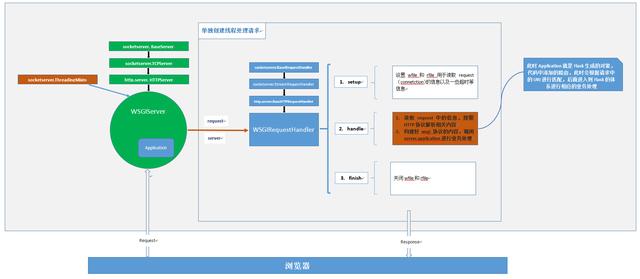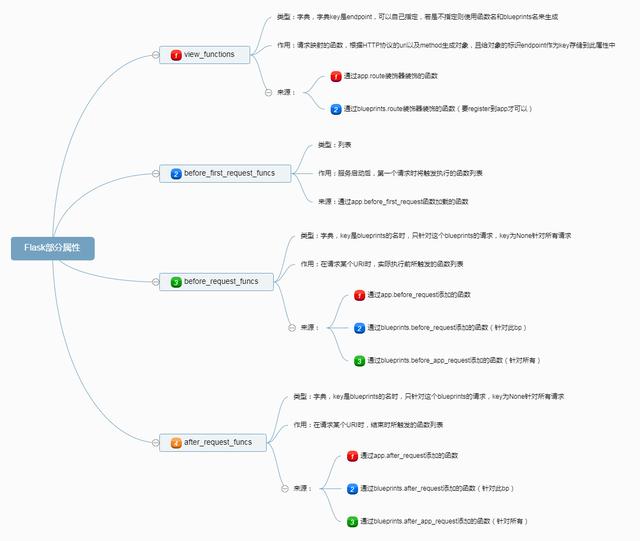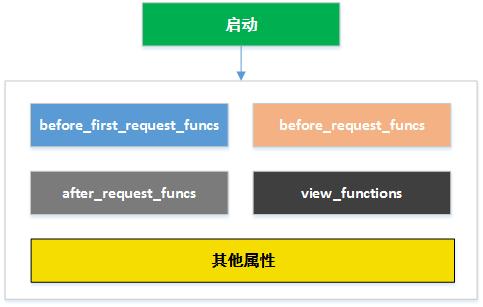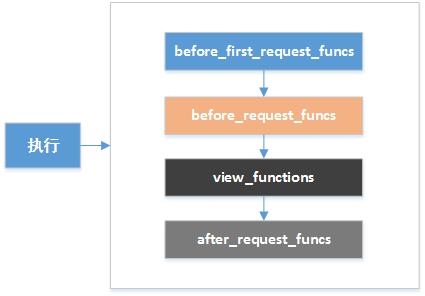您好,登錄后才能下訂單哦!
您好,登錄后才能下訂單哦!
Python基礎教程:Flask進擊篇——Flask運行流程
在我們了解Flask運行流程之前,先看一下我們在瀏覽器一次請求中所經歷的過程,下面這張是結合Flask的源碼繪制的一張流程圖

能看到Flask在一次請求中實際上只是做了最后一部分功能,這里沒有將Flask的具體處理流程列出來,我們在下面會繼續講解。
在上圖中出現WSGIRequestHandler,WSGI協議是在Python Web開發中很核心的部分,如果想繼續進擊的話,需要對這部分有深刻的理解。
這部分我在前面的 Python基礎教程有講到過!
我所理解Flask要做的事情,是根據請求的HTTP協議中url和method映射相應的處理函數,處理完并返回。這是基礎的功能,Flask在這基礎上又增加了一些其他功能。下面我們就通過Flask的源碼中一些屬性來進行分析。


Flask在啟動時已將各屬性根據需求配置好,但實際映射函數的屬性就是view_functions,此屬性類型為字典,key是endpoint。
endpoint可自定義,若不指定將會根據函數名生成,若出現重復的endpoint將會提示錯誤。
endpoint會與url和method統一封裝成到rule放入到url_map中,在請求過來時會根據url和和method生成reuqest到url_map中匹配,如果匹配到則根據endpoint獲取到相應的函數去執行,并將結果返回。這部分可以看Flask源碼部分。
添加到url_map
# flask/app.py
def add_url_rule(
self,
rule,
endpoint=None,
view_func=None,
provide_automatic_options=None,
**options
):
if endpoint is None:
endpoint = _endpoint_from_view_func(view_func)
options["endpoint"] = endpoint
methods = options.pop("methods", None)
if methods is None:
methods = getattr(view_func, "methods", None) or ("GET",)
if isinstance(methods, string_types):
raise TypeError(
"Allowed methods have to be iterables of strings, "
'for example: @app.route(..., methods=["POST"])'
)
methods = set(item.upper() for item in methods)
# Methods that should always be added
required_methods = set(getattr(view_func, "required_methods", ()))
# starting with Flask 0.8 the view_func object can disable and
# force-enable the automatic options handling.
if provide_automatic_options is None:
provide_automatic_options = getattr(
view_func, "provide_automatic_options", None
)
if provide_automatic_options is None:
if "OPTIONS" not in methods:
provide_automatic_options = True
required_methods.add("OPTIONS")
else:
provide_automatic_options = False
# Add the required methods now.
methods |= required_methods
rule = self.url_rule_class(rule, methods=methods, **options)
rule.provide_automatic_options = provide_automatic_options
self.url_map.add(rule)
if view_func is not None:
old_func = self.view_functions.get(endpoint)
if old_func is not None and old_func != view_func:
raise AssertionError(
"View function mapping is overwriting an "
"existing endpoint function: %s" % endpoint
)
self.view_functions[endpoint] = view_func
請求時匹配請求
1.生成請求
# flask/app.py def create_url_adapter(self, request): if request is not None: subdomain = ( (self.url_map.default_subdomain or None) if not self.subdomain_matching else None ) return self.url_map.bind_to_environ( request.environ, server_name=self.config["SERVER_NAME"], subdomain=subdomain, ) if self.config["SERVER_NAME"] is not None: return self.url_map.bind( self.config["SERVER_NAME"], script_name=self.config["APPLICATION_ROOT"], url_scheme=self.config["PREFERRED_URL_SCHEME"], ) # flask/ctx.py def match_request(self): try: result = self.url_adapter.match(return_rule=True) self.request.url_rule, self.request.view_args = result except HTTPException as e: self.request.routing_exception = e
此處是在生成上下文的push中執行會執行match_request,這里沒有貼出來。
實質就是請求過來了,根據url和method匹配啟動時的url_map,如果沒有的話則返回匹配不到
2.匹配請求
# flask/app.py def dispatch_request(self): req = _request_ctx_stack.top.request if req.routing_exception is not None: self.raise_routing_exception(req) rule = req.url_rule if ( getattr(rule, "provide_automatic_options", False) and req.method == "OPTIONS" ): return self.make_default_options_response() # otherwise dispatch to the handler for that endpoint return self.view_functions[rule.endpoint](**req.view_args)
根據上面從url_map得到的rule,然后根據endpoint取得要執行的函數。
Flask另外幾個屬性,則表示在請求之前和請求之后做一些處理,并且可以針對不同的blueprints來進行處理,關于blueprints我們等幾個章節再細分析。
Flask實際的處理流程是什么樣子,先看一下Flask的源碼
# flask/app.py # 1. 先通過wsgi協議到這個函數 def __call__(self, environ, start_response): return self.wsgi_app(environ, start_response) # 2. 然后調用這個函數,處理上下文 def wsgi_app(self, environ, start_response): # 下文處理!!! ctx = self.request_context(environ) error = None try: try: ctx.push() response = self.full_dispatch_request() except Exception as e: error = e response = self.handle_exception(e) except: # noqa: B001 error = sys.exc_info()[1] raise return response(environ, start_response) finally: if self.should_ignore_error(error): error = None ctx.auto_pop(error) # 3. 請求處理流程 def full_dispatch_request(self): self.try_trigger_before_first_request_functions() try: request_started.send(self) rv = self.preprocess_request() if rv is None: rv = self.dispatch_request() except Exception as e: rv = self.handle_user_exception(e) return self.finalize_request(rv)
基本流程可以看的比較清晰,至于每個函數列表的來源以及作用,我在開始的屬性圖上已將其標識出來。

至此可以大體知道請求過來之后Flask是如何處理及前期Flask會構建哪些內容。
但Flask還有很多東西。例如我們經常使用request,current_app對象和常用的blueprints是怎么個原理。
更多的 Python基礎教程也會繼續為大家更新!大家有什么想學的內容也可以留言或者私信我,人多的話,可以考慮出一期!最近也整理了一些Python基礎教程學習的視頻,有需要的伙伴可以留言私信我回復Python,僅30份!
免責聲明:本站發布的內容(圖片、視頻和文字)以原創、轉載和分享為主,文章觀點不代表本網站立場,如果涉及侵權請聯系站長郵箱:is@yisu.com進行舉報,并提供相關證據,一經查實,將立刻刪除涉嫌侵權內容。